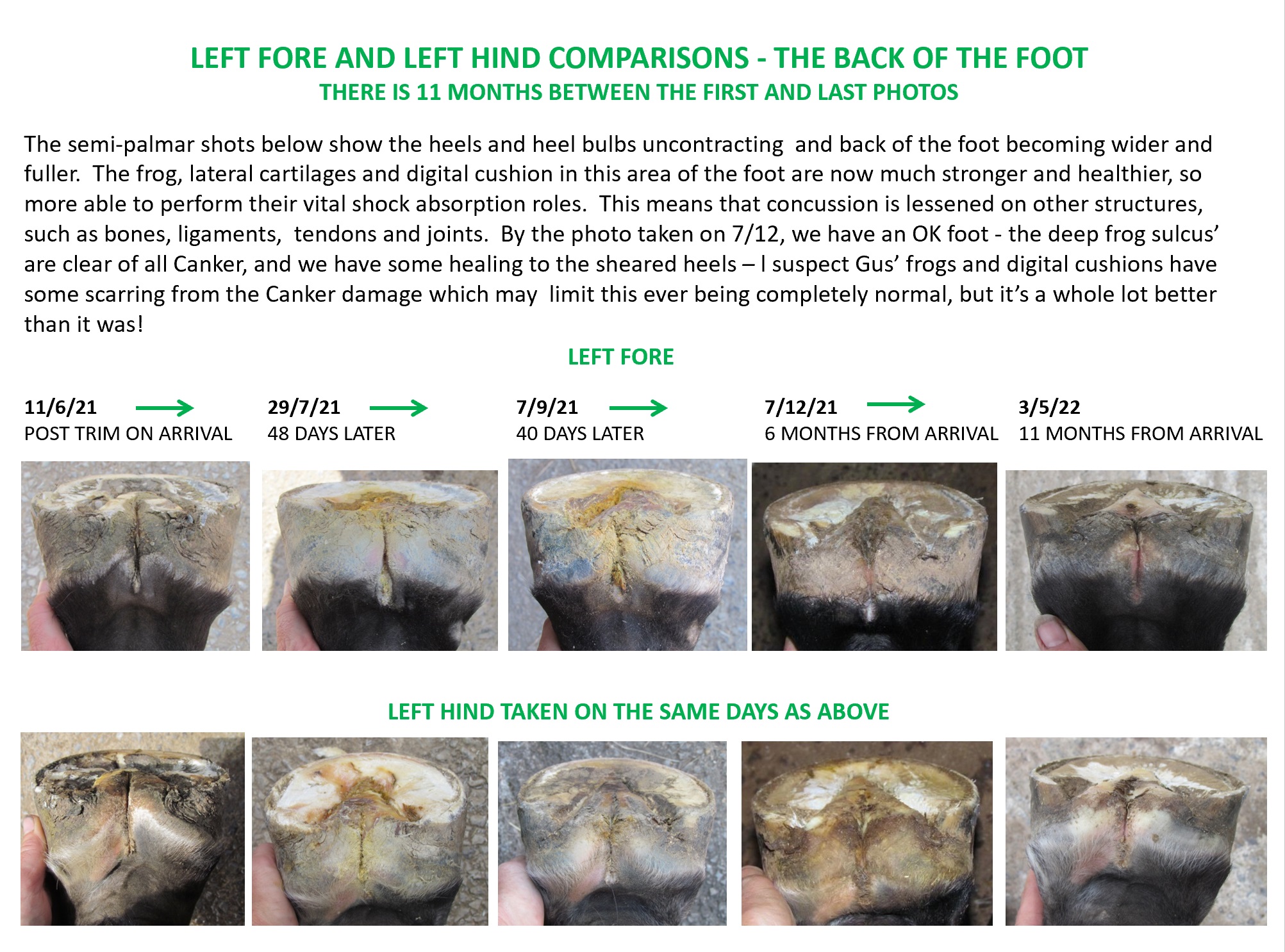Case History. ‘Gus’ a 13 year old Thoroughbred arrived at my yard in June 2021, suffering from Canker in all four feet. This had been worsening over the previous 12 months or so since first diagnosed, and was affecting his soundness and usability.
Traditional treatment usually involves aggressive surgical debridement of all affected tissue, done under anaesthetic or heavy standing sedation, and topical applications of antimicrobial drugs, whilst keeping the feet dressed and scrupulously clean, in dry environment. The hope is that the tissue will then grow back normally, but the prognosis is generally guarded, and it is not unusual for the canker to return.
Gus’s owner did not want to put him through this treatment unless there was no alternative….. The vet involved was very supportive of trying a different approach and acknowledged that as no-one really had the answers to this condition, an alternative was worth trying….
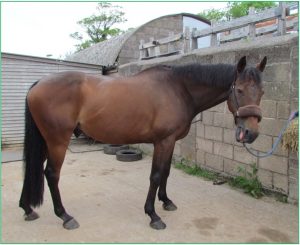
Gus was owned for the previous 9 years by the same owner and kept throughout at the same yard. No other horses at the yard were affected. Traditional management with no turnout in the winter, and often in during daytimes in the summer. Shavings/rubber clean stable environment. Fed general all-purpose horse and pony nuts as hard feed. Hay not available ad-lib. Always shod, fogs often bled when trimmed and was more recently often uncomfortable having his feet picked out. He was often sore on the arena surface as it irritated his frogs, but generally coped well on the roads.
First assessment
The canker was undoubtedly the most serious of the hoof pathologies, and his frogs were very sore to touch
His heels were also sheared where the canker had invaded his frog sulcus’s
His feet were contracted, with underun heels and negative palmar and plantar angles
The hind feet were also bullnosing
He was landing incorrectly flat on his front feet, and incorrectly toe first on his hind feet
Discussed with owner and it was decided to move him to a rehabilitation yard.
The vet was fully consulted about the planned approach, and supported the EP throughout. The vet also visited within a few days of Gus arriving at the yard, to discuss and help with the trimming approach for Gus’s frogs.
CANKER – RESEARCH AND PREPARATION
The Canker specific treatment was
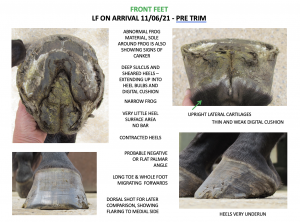
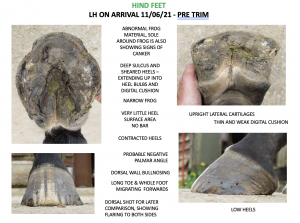
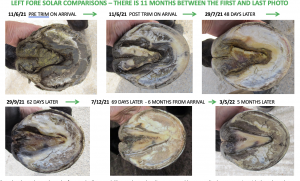
The solar shots above show the frog gradually remodelling as the canker disappears and better quality horn grows in, with the sulcus also becoming healthier. The build up of abnormal sole around the frog in the first two pictures is also changing as the solar corium recovers – it has become waxy yellowy repair horn by the third photo, is gradually then being replaced by healthy sole growing in, and is normal by the 7/12 photo. By the last photo the frog material is also completely normal! The heels and frog are uncontracting and becoming wider apart, and the whole foot is rounder (more correct for a horse of this type). The toe is coming back, improving breakover point. The heel surface area is fairly good and the bars, although still false, are straightening. The wall /white line are much healthier too.
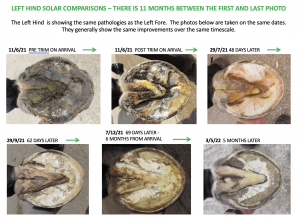
LEFT FORE COMPARISONS – 11 MONTHS IS EASILY TIME TO GROW A WHOLE NEW HOOF CAPSULE
The sequence of lateral and dorsal shots below show the new growth coming down from the coronary band at a much better angle, no new event lines, and less flaring. It is far stronger, better quality hoof horn. By the time of the last photo in each row, Gus had grown a whole new hoof capsule which had been under correct influences, making it healthier and more correct. The whole foot has stopped migrating forwards, and is coming back underneath the limb, easing the breakover at the toe. The heel placement is further back, and just needs slightly more improvement. If you look at the hairline it has stopped ‘curling under’ at the heels and become straighter, meaning the digital cushion and lateral cartilages here are fuller and stronger – you can see this nicely on the last lateral photo here, and the semi-palmar shots on page 10.This has begun to correct the collapsed internal arch. All of this has created a much better hoof pastern axis – you can see this by comparing the pastern /dorsal hoof wall angles to the ground in the first and last photos. This means less strain on joints, tendons, ligaments and muscles further up the limb too.
Because Gus’ feet were initially so poorly, he needs more time to continue developing the best hoof he can. There is a chance his frogs and digital cushions are permanently scarred from the Canker damage, so this could limit the improvement to the back of his feet – Only time will tell. NB In the last Dorsal photo, we have a little minor white line disease, associated crack and disruption at the toe – 2 months later this had cleared up.
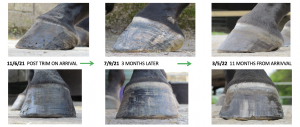
LEFT HIND COMPARISONS – 11 MONTHS IS EASILY TIME TO GROW A WHOLE NEW HOOF CAPSULE
The sequence of lateral and dorsal shots below show the new growth coming down from the coronary band at a better angle, no new event lines, and less flaring. It is far stronger, better quality hoof horn. By the time of the last photo in each row, Gus had grown a whole new hoof capsule which had been under correct influences, making it healthier and more correct. Although improvements still need to be made to the low heels and plantar angles, we have made a good start, and things are now going in the right direction! The whole foot has stopped migrating forwards, and is coming back underneath the limb, easing the breakover at the toe. The heel placement is further back, and the wall here is at a correct angle. The hairline has stopped ‘curling under’ at the heels and become straighter, meaning the digital cushion and lateral cartilages here are fuller and stronger – you can see this nicely on the last lateral photo here, and the semi-palmar shots on page 10. This has begun to correct the collapsed internal arch. The dorsal wall has stopped bullnosing, affirming that he is now landing correctly heel first. All of this has started to create a better hoof pastern axis – you can see a slight improvement when comparing the pastern /dorsal hoof wall angles to the ground in the first and last photos. This means less strain on joints, tendons, ligaments and muscles further up the limb too.
Because Gus’ feet were initially so poorly, he needs more time to continue developing the best hoof he can. There is a chance his frogs and digital cushions are permanently scarred from the Canker damage, so this could limit the improvement to the back of his feet – Only time will tell.
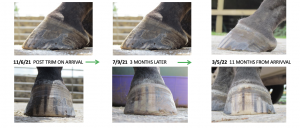
GUS RETURNED HOME AFTER SPENDING 10 MONTHS WITH US….
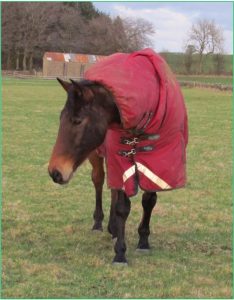
Whilst we treated his feet, we didnt have to sedate him, he had no surgical or painful debridement of the infected areas. We didnt have to change dressings, worry about exposed live tissue and we was able to be turned out 24/7 – even in the mud!
